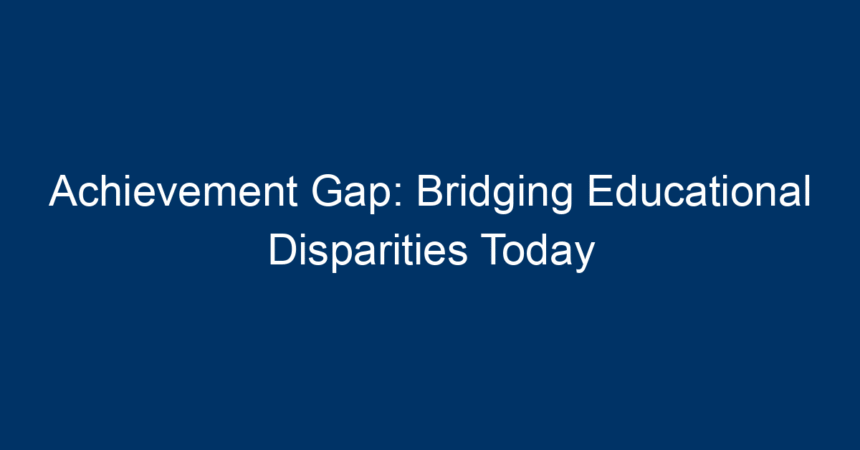In an increasingly globalized world, the achievement gap represents one of the most pressing challenges in the educational landscape. Defined as the significant disparity in academic performance between different groups of students—often influenced by socioeconomic status, race, and geographic location—this gap has far-reaching implications for students, communities, and society as a whole. Understanding the causes of the achievement gap and exploring effective strategies to bridge it is crucial for creating a more equitable educational system. This article delves into the factors contributing to the achievement gap, examines current initiatives aimed at reducing disparities, and provides actionable insights for educators, parents, and policymakers.
Understanding the Achievement Gap
Definition and Importance
The achievement gap refers to the observed difference in educational performance among various groups of students. Commonly measured through standardized test scores, graduation rates, and overall academic performance, the gap highlights the inequalities present in educational access and outcomes. Understanding this disparity is vital, as it not only affects individual students but also has consequences for economic growth and social cohesion.
Historical Context
Historically, educational disparities have often aligned with systemic issues such as discrimination, socio-economic inequalities, and inadequate funding for schools in low-income areas. From the segregation era to modern times, these factors have consistently inhibited equal educational opportunities across diverse demographics.
Causes of the Achievement Gap
Socioeconomic Factors
One of the primary contributors to the achievement gap is socioeconomic status. Children from low-income families frequently attend underfunded schools, lack access to quality early childhood education, and face obstacles such as food insecurity. These challenges significantly influence their readiness for school and ongoing academic performance.
Racial and Ethnic Disparities
The achievement gap is also affected by racial and ethnic disparities. Minority students often experience systemic barriers that hinder their educational success. Factors such as implicit biases within the education system, lower expectations from teachers, and lack of representation in the curriculum can adversely impact these students’ academic journeys.
Geographic Disparities
Geographic location can have a profound effect on educational opportunities. Students in rural areas may contend with limited access to advanced coursework, extracurricular activities, and qualified teachers. Conversely, urban students might struggle with overcrowded classrooms and higher dropout rates, further widening the achievement gap.
Strategies to Bridge the Achievement Gap
Early Childhood Education
Investing in high-quality early childhood education is one of the most effective strategies to close the achievement gap. Programs that offer support for low-income families can ensure that children enter kindergarten ready to learn. Research has consistently shown that early intervention can significantly improve academic outcomes for at-risk children.
Teacher Training and Development
Teacher effectiveness is crucial in addressing the achievement gap. Ongoing professional development that focuses on culturally responsive teaching, differentiated instruction, and inclusive practices can empower educators to meet the diverse needs of their students. By equipping teachers with these essential skills, schools can foster a more equitable learning environment.
Parental Involvement
Engaging parents in their children’s education is vital for bridging the achievement gap. Schools can facilitate this by providing resources and support systems to help families navigate academic challenges. Programs that encourage parental involvement—such as workshops, seminars, and community events—can create a more supportive educational ecosystem.
Policy Changes and Funding
Advocating for policy changes that promote equitable funding across schools is essential. This includes reallocating resources to underfunded schools, investing in technology, and providing access to essential educational materials. Policymakers must prioritize equitable funding to ensure that all students, regardless of their background, have access to quality education.
Innovative Programs Addressing the Achievement Gap
Mentorship Programs
Mentorship programs have emerged as a promising strategy for narrowing the achievement gap. These programs connect students with mentors—often professionals or older students—who can provide guidance, support, and encouragement. By fostering positive relationships, mentors can help students navigate challenges and develop essential life skills.
After-School and Summer Programs
After-school and summer programs focused on academic enrichment can significantly impact students from disadvantaged backgrounds. These programs provide additional learning opportunities, help improve academic performance, and offer a safe space for students to explore their interests.
Technology Integration
Integrating technology into the classroom can enhance learning experiences and help bridge the achievement gap. By providing access to digital resources, personalized learning platforms, and virtual tutoring, schools can broaden educational opportunities for all students, regardless of their socioeconomic status.
The Role of Community
Community Partnerships
Building partnerships with community organizations can enhance resources and support for struggling students. Collaborations with local businesses, nonprofits, and higher education institutions can provide additional resources, such as tutoring, mentorship, and funding for educational initiatives.
Advocacy and Awareness
Raising awareness about the achievement gap is crucial for mobilizing community action. Local advocacy groups can drive conversations around educational disparities, encouraging community members to engage in efforts aimed at closing the gap. Public forums, social media campaigns, and community events can serve as platforms for discussing these issues.
Conclusion: Bridging the Achievement Gap
The achievement gap is a multifaceted issue that demands a comprehensive and collaborative approach. By understanding its root causes and implementing effective strategies, we can work towards a more equitable educational landscape. From investing in early childhood education to fostering community partnerships, each stakeholder—educators, parents, policymakers, and community members—has a vital role in this mission.
Actionable Insights
-
Support Early Education Initiatives: Advocate for policies that fund early childhood education programs in your community.
-
Engage with Local Schools: Attend school board meetings and offer your support to initiatives aimed at bridging the achievement gap.
-
Become a Mentor: Consider mentoring a student in your community, providing guidance and encouragement.
-
Promote Parental Involvement: Organize or participate in workshops that help parents navigate the educational system.
- Advocate for Equitable Funding: Contact local representatives to share your concerns about educational disparities and advocate for equitable funding.
By taking these steps, we can collectively contribute to bridging the achievement gap and ensuring every student has the opportunity to succeed.




